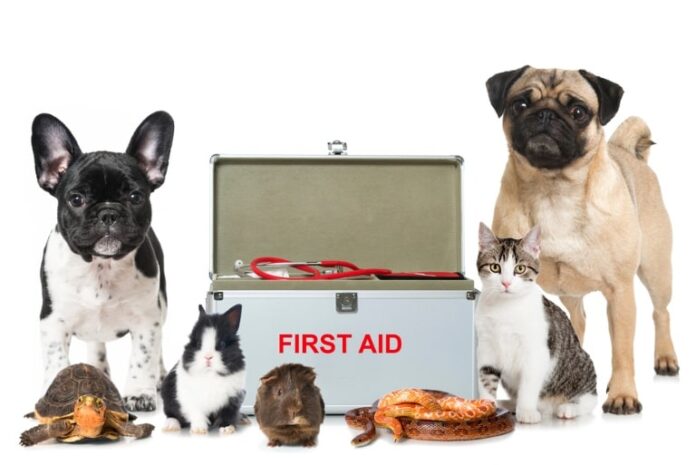Accidents and emergencies can happen when you least expect them, even to your beloved pets. Whether it’s a minor scratch, an insect sting, or something more serious, it’s important to have a well-stocked first aid kit so you can act quickly and get your pet the help they need.
Let’s take a look at the must-have items every pet owner should keep on hand in a first aid kit, how you can tailor this to your pet’s specific needs, and when it’s time to get professional help.
Why Every Pet Owner Needs a First Aid Kit
From your dog cutting its paw while on a walk to your cat or rabbit eating something they shouldn’t, accidents can happen at any time, even when you try your best to prevent them. This is where having a first aid kit on hand can help you act quickly to provide fast and immediate care before taking them to the vet (if further treatment is needed).
Using one can potentially save your pet’s life or prevent issues from progressing further before you can visit your vet. A well-prepared first aid kit can help you manage bleeding, prevent infection, ease pain, and reduce stress when your pet needs immediate attention.
It’s important to remember that first aid isn’t a replacement for professional vet care, so after providing initial medical care for your pet, you should contact your vet as soon as possible to be on the safe side.
Basic Supplies to Include in Your First Aid Kit
So, what does a good first aid kit look like? Well, it should have supplies that can be used to cope with minor injuries or any unexpected emergencies. As per the PDSA, a well-stocked first aid kit for pets should have supplies such as bandages, blunt-end scissors, wound wash and cotton wool. The kit should also have tweezers, self-adhesive tape, dressings, vinyl gloves, and antiseptic wipes. A blanket can also come in handy, as it can not only comfort your pet but also act as a stretcher to carry them if need be.
It can be helpful to have your pet’s medical documents in a nearby folder in case you need to take your pet to the vet. You might also want to pack a pet first aid guide so you can read tips on how to help your pet in an emergency, especially if you are away from home, or keep a copy on your smartphone, where possible. This could be anything from how to wrap bandages to what to do if your pet is stung by an insect.
As per the Blue Cross, you shouldn’t give your pet human medication (such as pain killers) under any circumstances, as they can be highly toxic for dogs and other animals. If you’re unsure for any reason, check with your vet before you add medication to your pet’s first aid kit.
Tailoring the Kit to Your Pet’s Needs
Every pet is unique, so your first aid kit should be tailored to suit their needs. While all pets can benefit from basic supplies such as bandages and tweezers, you can add certain other supplies based on your pet’s species, breed, age, and any pre-existing health conditions.
If you have a cat, claw clippers can be a good idea if their claws split or get snagged on something. You might also want to add cat-specific calming spray into your kit, which can help keep your cat relaxed. As a dog owner, booties or paw balm can help protect your pet’s injured paws, while a thermometer can help you gauge whether your dog has a fever or not.
You may want to add prescribed medicine to the first aid kit, which can act as a handy backup should you lose your pet’s main prescription medicine. It’s also a good idea to discuss your first aid kit with your vet in case they have suggestions of items you should add, such as a glucose source (like honey) if your pet is diabetic.
Travel-Ready – Making a Portable First Aid Kit
If you’re out and about with your pet, a portable first aid kit is essential, especially if you are a long way from a veterinary surgery or your pet has pre-existing health problems. A portable first aid kit should be lightweight enough so that you can easily transport it and filled with important supplies that can be used for various purposes.
You may want to pack bandages, tweezers, and antiseptic wipes in your portable first aid kit, along with disposable gloves and a collapsible water bowl to make sure your pet stays hydrated.
A waterproof bag and disposable bags can also be handy to have in the kit, as can a spare lead and collar (particularly for dogs). It’s important to check your supplies regularly to see if anything needs to be restocked or if anything has expired and needs to be replaced.
Where to Store Your Pet First Aid Kit
It doesn’t matter how well stocked your pet’s first aid kit is if you can’t find it in an emergency. Your kit should be kept tidy and well-stocked in an accessible location such as a kitchen cabinet, bathroom cupboard, or in the boot of your car (if it’s a transportable kit).
Make sure to keep your pet’s first aid kit away from your human first aid kit so you don’t mistake one for the other. If possible, having these in different colours can be helpful, especially when in a hurry. You may want to keep your supplies in a hard case with separate compartments to help keep the box organised.
You should keep your first aid kit away from heat sources and humid areas, too, as this will prevent the supplies from losing their effectiveness too quickly. If you have medication or temperature-sensitive items in the kit, you shouldn’t keep it in the car for long periods, either, especially during the summer.
How to Prepare for the Worst to Give Your Pet the Best Care
As difficult as it is to imagine your beloved pet in pain or distress, it’s important to think ahead so you can be prepared in case of emergencies, whether it’s an accident or sudden illness. Along with having a first aid kit handy for your pet, you should also know where your nearest emergency vet clinic is and keep your pet’s medical records updated.
If you haven’t already, it’s also advisable to have suitable pet insurance to help manage the costs of emergency treatment and care should your pet need it. Without insurance, the vet bills can quickly add up, which can put a strain on your finances and potentially cause a delay in treatment.
While you can’t prevent every accident or illness from happening, you can prepare for them. Having a first aid kit on hand for your pet will help make sure they have the best care before you can get them to a vet, and (in some cases) be the difference between life and death.
Stay vigilant when inside or outside the home, as prevention is always the best solution to avoid anything serious from happening. That way, you can enjoy your time together in a safe environment, no matter where you are.




